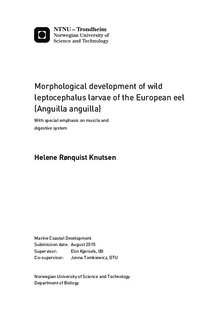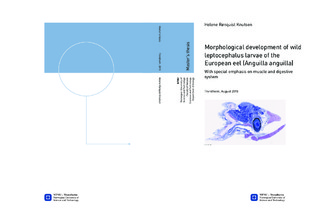| dc.description.abstract | The larval stage of the European eel (Anguilla anguilla) is largely undescribed. Increased knowledge about the ontogeny of the eel is be of interest both in an ecological perspective, but also in relation to a conservation, as the eel stocks in Europe has experienced major declines over a very short period of time. Eel is also a potential candidate for production in aquaculture, where the early life stages are most challenging, mainly in relation to start-feeding the larvae. In the present study, the functional development and morphology of wild captured leptocephalus larvae of the European eel was described. The study had special emphasize on the digestive system and muscle, as this is considered especially important for the survival of fish larvae. Descriptions and measurements were made of the sensory organs (eyes, olfactory organ, taste buds, neuromasts, ear), brain and neurons, circulatory system, respiratory organs, skin and skeleton. Growth and development of the larvae in relation to standard length was also investigated. External and internal descriptions and measurements were performed, and different histological methods and techniques were used.
The digestive system appeared to be very similar to the Japanese eel, apart from the muscular anterior esophagus with the rough surface, which is hypothesized to have a food-crushing function. This might explain the long and fragile teeth of the leptocephalus larvae that are thought have a grasping function, rather than being used for biting or chewing. The muscle tissue of the larvae had a unique morphology with a thin, almost stacked layer covering the gelatinous matrix in the middle. This may be unique to the leptocephalus larvae, and has previously only been described for yolk-sac larvae. The muscle of the larvae was found to grow mainly by hypertrophy. The main growth both in number and size of muscle happened in the middle of the larvae, indicating that they grow in length both from the tail area and head area. The skin was covered in a cell layer, probably consisting of a large proportion of the lectin-secreting club cells based on the findings for the Japanese and American eel. This thought to be of importance in relation to protection of the larvae. It might seem that the leptocephalus larvae have a unique development of the eye, based on the observation of golden retinal pigmentation in all larvae and a highly developed eye in the largest larva. It seems to be something important happening both with respect to growth and organ development between the size 18 and 23 mm, as there for almost all organ systems that were viewed could be observed a major difference between the largest specimen and the other larvae, especially in relation to the development of the eye, finrays and in the muscle tissue. | |

